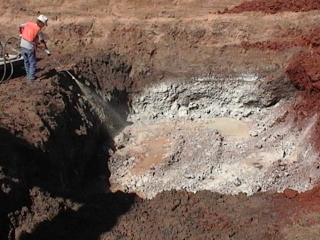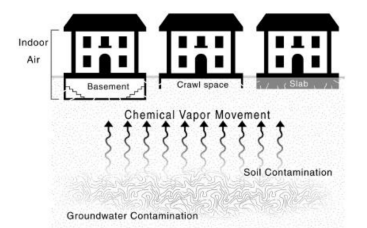Guidance for Cleaning Up Groundwater, Soil and Air at Hazardous Waste Cleanup Facilities
Accidents or other activities at Resource Conservation and Recovery Act (RCRA) facilities sometimes result in releases of hazardous waste or hazardous constituents into soil, groundwater, surface water, sediments, or air. Corrective action requires such facilities to conduct investigations and cleanup actions (remediation of the contamination) as necessary to protect human health and the environment. EPA developed guidance documents to assist regulators and members of the regulated community and the public in understanding and implementing hazardous waste cleanup of different types of media, including groundwater, soil, and air (vapor intrusion) after a release has occurred.
Guidance documents do not impose legally binding requirements on EPA, States, or the regulated community, and may not apply to a particular situation based upon the specific circumstances of the hazardous waste cleanup facility. EPA’s legal authority to require facility-wide cleanup comes from RCRA.
On this page:
- Guidance for Groundwater Cleanups
- Guidance for Soil/Sediment Cleanups
- Guidance for Air (Vapor Intrusion) Cleanups
- Additional Resources
Guidance for Groundwater Cleanups
EPA’s hazardous waste cleanup goal for groundwater is to prevent adverse effects to human health and the environment, both now and in the future. EPA believes that short-term exposure prevention and long-term cleanup goals are both essential elements to achieve this overall goal. With respect to short-term exposure prevention, EPA works with hazardous waste cleanup facilities to interrupt current and prevent new exposures through groundwater ingestion. With respect to long-term cleanup goals, facilities and regulators generally focus first on cleanup activities that limit exposures to humans. Then the focus shifts to cleaning up and restoring currently used and reasonably expected sources of drinking water as well as groundwater that is closely hydraulically connected to surface waters, whenever such restorations are practicable and attainable.
EPA developed groundwater guidance to help regulators, members of the regulated community, and members of the public better understand EPA’s groundwater cleanup approaches, technical protocols, and policies. Additionally, EPA recommends that facilities, regulators, and members of the public use these guidance documents to focus discussions and to ultimately improve the quality of groundwater at and near cleanup facilities.
Guidance Documents Pertaining to Groundwater
| Name of Document | Description of Document |
|---|---|
|
|
This handbook and the accompanying documents are designed to help regulators, members of the regulated community, or members of the public find and understand EPA policies on protecting and cleaning up groundwater at RCRA Corrective Action facilities. This handbook contains EPA’s interpretation of policies on such topics as cleanup goals, the role of groundwater use, point of compliance, source control, and monitored natural attenuation. |
| Technical Protocol for Evaluating Natural Attenuation of Chlorinated Solvents in Groundwater (pdf) (24.7 M) |
The intent of this document is to present a technical protocol for data collection and analysis to evaluate monitored natural attenuation through biological processes for remediating groundwater. Natural attenuation processes, such as bio-degradation, can often be dominant factors in the fate and transport of contaminants. Thus, consideration and quantification of natural attenuation is essential to a more thorough understanding of contaminant fate and transport. |
| Use of Monitored Natural Attenuation at Superfund, RCRA Corrective Action and Underground Storage Tank Sites (286 KB) |
The purpose of this Directive is to clarify EPA’s policy regarding the use of monitored natural attenuation (MNA) for the cleanup of contaminated soil and groundwater in the Superfund, RCRA Corrective Action, and Underground Storage Tank programs. |
| Guidelines for Groundwater Classification Under the 1984 EPA Groundwater Protection Strategy, Final Draft (pdf) (10.3 KB) |
The purpose of this document is to further define the classes, concepts, and key terms related to the classification system outlined in the 1984 Groundwater Protection Strategy, and to describe the procedures and information needs for classifying groundwater. |
| Waste Management Area (WMA) and Supplemental Well (SPW) Guidance |
This document gives an overview of the waste management area and the supplemental well provisions of the RCRA Subtitle C groundwater monitoring regulations of 1988. These provisions were intended to increase flexibility in the RCRA groundwater monitoring program, so that monitoring systems may be better tailored to site-specific conditions and designed to foster the early detection of contaminated releases. |
| Alternate Concentration Limit Guidance |
|
| Protecting the Nation's Groundwater: EPA's Strategy for the 1990's |
|
|
|
These documents provide guidance on RCRA Section 3020(b). RCRA section 3020(a) bans hazardous waste disposal by underground injection into a formation which contains an underground source of drinking water (within one-quarter mile of the well), or above such a formation. However, RCRA section 3020(b) exempts from the ban re-injection of treated contaminated ground water withdrawn from an aquifer, if certain criteria are met. |
| Final Comprehensive State Groundwater Protection Program Guidance |
These documents are intended to describe the Comprehensive State Groundwater Protection Programs (CSGWPPs). CSGWPPs are the focal point for a new partnership between EPA, the States, Native American Tribes, and local governments to achieve a more efficient, coherent, and comprehensive approach to protecting the nation’s groundwater resources. Protecting groundwater sources usually requires the combined efforts of many partners such as public water systems, communities, resource managers, and the public. |
| State Source Water Assessment and Protection Programs Guidance (pdf) (6.9 MB) |
The purpose of this document is to provide guidance required by the Safe Drinking Water Act (SDWA) Amendments of 1996 for state Source Water Assessment Programs (SWAP) and for Source Water Petition (SWP) Programs. This document describes the elements of an EPA-approvable SWAP submittal as well as EPA’s recommendations for what may be included in an SWP Program. |
Guidance for Soil/Sediment Cleanups

EPA’s hazardous waste cleanup goal with respect to contaminated soil and sediment is to prevent adverse effects to human health and the environment by protecting the integrity of the nation’s soil/sediment resources. EPA believes that short-term exposure prevention and long-term cleanup goals are essential elements of a strategy designed to achieve this overall goal. With respect to short-term exposure prevention, EPA works with facilities to interrupt current and prevent new exposure via direct pathways (e.g., dermal exposures, incidental ingestion, and inhalation of soils and dusts) as well as indirect pathways (e.g., ingestion of food crops and fish production).
EPA also works with facilities in the short-term to address soil and sediment exposure routes that may cause negative impacts to ecosystems. With respect to long-term cleanup goals, facilities and regulators generally focus first on cleanup activities to limit the risk to human health by limiting exposure. Then the focus shifts to cleaning up contaminated soils and sediments that are currently being used or reasonably expected to be used for residential or food production purposes or that are causing significant ecological impacts, whenever such restorations are practicable and attainable.
There are many methods of treating or cleaning-up contaminated soils and sediments including both in-situ (treating in the ground) and ex-situ (removal of soil to treat) remediation considerations. The main methods used include containment, soil washing, thermal treatment, vapor extraction, bioremediation, incineration, and other physical/chemical treatments.
Guidance Documents Pertaining to Soil/Sediment Cleanups
| Name of Document | Description of Document |
|---|---|
| Best Management Practices for Soil Treatment Technologies |
|
| Clarification to the 1994 Revised Interim Soil Lead Guidance for CERCLA Sites and RCRA Corrective Action Facilities | This directive clarifies the policy on using EPA’s Science Advisory Board reviewed Integrated Exposure Uptake Biokinetic Model and blood lead studies, determining the geographic area to use in evaluating human exposure to lead contamination, addressing multimedia lead contamination, and determining appropriate response actions at lead sites |
| Soil Treatment Standards (pdf) (82.4 KB) |
|
Guidance for Air (Vapor Intrusion) Cleanups

Vapor intrusion is the general term given to the migration of hazardous vapors from a subsurface vapor source (i.e., contaminated soil or groundwater) into the indoor air of an overlying building or structure. These vapors can enter buildings through cracks in basements and foundations, as well as through conduits and other openings in the building envelope. All types of buildings, regardless of foundation types (e.g., basement, crawl space, slab-on-grade), have openings that render them potentially vulnerable to vapor intrusion.
When and where vapor intrusion occurs, concentrations of vapors can increase gradually in amount in buildings or structures as time passes (i.e., “accumulate”). Depending upon site- and building-specific circumstances, vapors of potentially toxic chemicals may accumulate to a point where the health of the occupants (e.g., residents, workers, etc.) in those buildings could be threatened. In addition to their toxicity threats, methane and certain other vapor-forming chemicals can pose explosion hazards depending upon structure-, building-, and site-specific circumstances. Explosion hazards may pose an imminent and substantial danger to human health and public welfare.
Response actions to address vapor intrusion when it poses unacceptable human health risks typically entail a combination of remediation to reduce or eliminate subsurface vapor sources; engineered exposure (mitigation) controls for specific buildings to reduce vapor intrusion or reduce concentrations of vapor-forming chemicals that have already entered the building; monitoring to assess and verify the performance and effectiveness of the remediation systems and engineered exposure controls; and institutional controls to restrict occupancy and land use and/or to alert parties (e.g., prospective developers, owners, and municipalities) of the presence of subsurface sources of vapor-forming chemicals and to foster operation, maintenance, and monitoring of the remediation systems and engineered exposure controls.
Guidance Documents Pertaining to Air (Vapor Intrusion) Cleanups
| Name of Document | Description of Document |
|---|---|
| Fact Sheet: Evaluating the Vapor Intrusion into Indoor Air |
|
| Technical Guide for Assessing and Mitigating the Vapor Intrusion Pathway from Subsurface Vapor Sources to Indoor Air |
|
| Background Indoor Air Concentration of Volatile Organic Compounds in North America Residences (1990-2005): A Compilation of Statistics for Assessing Vapor Intrusion |
This technical report presents a summary of indoor air studies that measured background concentrations of Volatile Organic Compounds (VOCs) in the indoor air of thousands of North American residences and an evaluation and compilation of the statistical information reported in these studies. The objective of this compilation is to illustrate the ranges and variability of VOC concentrations in indoor air resulting from sources other than vapor intrusion. |
| Conceptual Model Scenarios for the Vapor Intrusion Pathway |
|
| Technical Guide for Addressing Petroleum Vapor Intrusion at Leaking Underground Storage Tank Sites |
This guidance focuses on releases of petroleum-based fuels (e.g., gasoline, diesel) from underground storage tanks (USTs), which are typically located at gas stations. This guide applies to new and existing releases of petroleum-based fuels from leaking USTs and to previously closed sites, where the implementing agency has reason to suspect that there may be a potential for petroleum vapor intrusion. |
| EPA's Vapor Intrusion Database: Evaluation and Characterization of Attenuation Factors for Chlorinated Volatile Organic Compounds and Residential Buildings |
|
